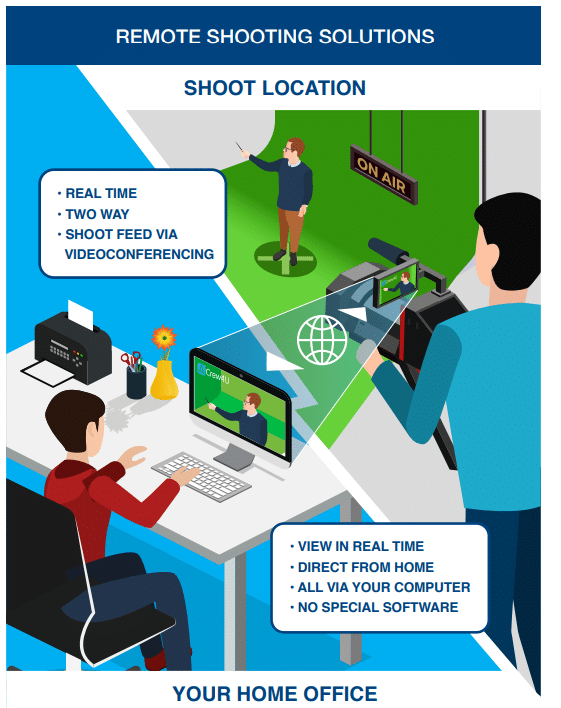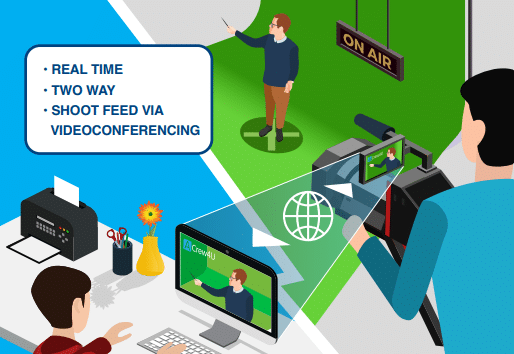Revolutionising Corporate Production: The Rise of Remote Shooting
Remote shooting is a simple yet amazingly effective process. We use off the peg video call technology to allow you to dial in to and attend and direct a shoot anywhere in the world.
Our local crew have a two-way-feed to a video call you join on Zoom or Teams.
All you need is your laptop and checklist and mobile phone to attend and direct a shoot. At the end you get 4k footage delivered online, on the same day.

Advantages of Remote Shooting:
1. Presence Without Physical Presence
Remote shooting enables individuals to transcend geographical barriers effortlessly. By leveraging live video feeds and communication tools, you can be virtually present at any location in the world. This not only eliminates the need for extensive travel but also opens up opportunities for collaboration on a global scale. With real-time communication, using off the peg tools. Clients can actively participate in the shoot process, providing feedback and direction regardless of their physical location.
2. Unprecedented Efficiency
Gone are the days of being confined to a single location for a shoot. Remote shooting empowers professionals to capture content in multiple cities within a single day. You can start the day in Singapore,head over to Lisbon around lunchtime, and round the day off with interviews in New York and San Francisco. All without leaving your desk!
Remote shooting offers unparalleled agility and speed. With local crews and down-the-line collaboration, projects can progress at the speed of light. Helping you meet even the most demanding deadlines with ease.
3. Sustainable Solutions
In an age where sustainability is paramount, remote shooting presents itself as a greener alternative to traditional methods. By minimising travel requirements, remote shooting significantly reduces carbon emissions associated with transportation. The ability to conduct shoots remotely also eliminates the need for extensive equipment transportation, further lowering the ecological footprint of the production process. Aditionally, by streamlining workflows and reducing resource consumption, remote shooting promotes a more environmentally conscious approach to photography and cinematography.
Sustainability of Remote Shooting:
1. Reduced Carbon Footprint
Remote shooting drastically reduces the carbon footprint associated with traditional shoots. By eliminating the need for extensive travel and equipment transportation, remote shooting minimises emissions, contributing to a cleaner and more sustainable environment. With the rise of climate consciousness, embracing remote shooting is not only practical but also ethical, aligning with efforts to combat climate change.
2. Resource Optimization
Remote shooting optimises the utilisation of resources by streamlining workflows and minimising waste. With the ability to organise shoots in a matter of hours and deliver rushes promptly, remote shooting reduces the need for prolonged production schedules and excessive resource consumption. By maximising efficiency and minimising downtime, remote shooting ensures that resources are utilised judiciously, promoting a more sustainable approach to photography and cinematography.
3. Encouraging Virtual Collaboration
Remote shooting fosters virtual collaboration and remote work practices, reducing the need for physical gatherings and travel. By leveraging video conferencing technology and online platforms, professionals can collaborate seamlessly from different locations, eliminating the need for unnecessary travel and reducing associated emissions. Embracing virtual collaboration not only enhances efficiency and productivity but also contributes to a more sustainable future by minimising the environmental impact of traditional shoot setups.
In conclusion, remote shooting represents a paradigm shift in the world of production, offering unprecedented flexibility, efficiency, and sustainability. By harnessing the power of technology, professionals can transcend geographical boundaries, meet tight deadlines, and minimise their ecological footprint. As the industry continues to evolve, remote shooting is poised to become the new standard, revolutionising the way we capture and create visual content in a rapidly changing world.

